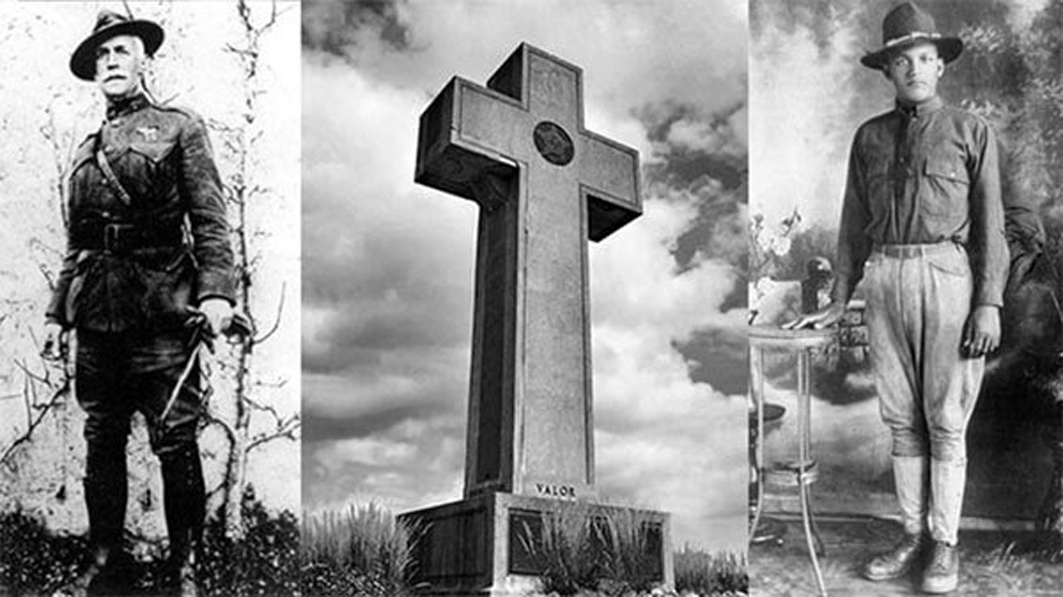In early 1918, Howard H. Morrow was too young to register for the military draft. But that didn’t stop him. Joining the National Guard, he found his way to the Western Front just after he turned eighteen. He didn’t make it to nineteen. In October, Morrow died from “multiple gunshot wounds” sustained fighting in the Great War.
Two weeks before his death, the Army awarded Howard the distinguished service cross for rescuing a comrade under fire.
On the one-year anniversary of his death, his mother, sisters, and brothers wrote, “Our thoughts are always wandering to the graves so far away where are dear son and brother is lying.”
In Bladensburg, Maryland, a cross-shaped memorial stands as a reminder of the 49 soldiers from Prince George’s County – including young Howard – who sacrificed their lives fighting in World War I. In 1925, The American Legion, now the largest veterans service organization in the country, erected the Bladensburg World War I Veterans Memorial to honor those fallen.
Gold Star mothers like Howard’s chose the memorial’s cross-shape because it was reminiscent of the crosses that marked the American graves scattered across the Western Front of the war. At the time, many of the men honored were laid to rest in France so the memorial served as a domestic gravestone.
Originally erected on private property, the land was taken over by the State of Maryland to expand the highway next to which the memorial now sits.
Cue a group of humanists. After 90+ years, they were the first to attack the memorial’s existence, claiming that a structure shaped like a cross is too much religion on government property. Last year, the U.S. Court of Appeals for the Fourth Circuit agreed with them and concluded that the presence of the veterans memorial violates the U.S. Constitution’s Establishment Clause.
My firm, First Liberty Institute, and our network attorneys at the international law firm Jones Day, represent the approximately 2 million members of The American Legion. We appealed the Fourth Circuit ruling to the U.S. Supreme Court and recently, the justices announced that they will hear our appeal.
On behalf of The American Legion, the Gold Star mothers of those memorialized, and the soldiers themselves, we hope to preserve the memories of the men honored at Bladensburg whose courage helped to shape our history and preserve our freedom. Included among those like Howard Morrow are Henry Seaburn, Joseph H. Ford, and William Lee who served in the historic 372nd United States Infantry, 93rd Division, a segregated unit for African American soldiers known as the “Red Hand Division.”
We forget what we do not see. The Gold Star mothers and The American Legion who erected the Memorial to 49 sons, brothers, and husbands of Prince George’s County did so with the hope that future generations would not forget their sacrifice. This November marks the 100th anniversary of the armistice, the official end of WWI. Although the boys of Prince George’s county are long gone, the Bladensburg Memorial stands as an ode to their bravery like dog tags resting in the hands of a fallen soldier.
Now, the memorial is at the mercy of nine justices on the U.S. Supreme Court who will decide its fate. Only they can save the Bladensburg World War I Veterans Memorial and guarantee that it and the two World War I memorials in Arlington National Cemetery and the hundreds of other memorials across the country are left to stand in peace.
For the sake of our history and future generations, we will fight to ensure that the memory of the boys of Bladensburg is not forgotten.
Keisha Russell is Associate Counsel to First Liberty Institute, a non-profit law firm dedicated to defending religious freedom for all. Read more at FirstLiberty.org.






